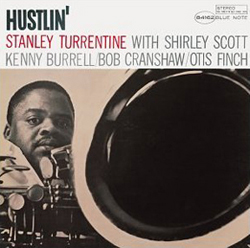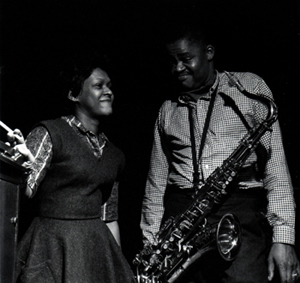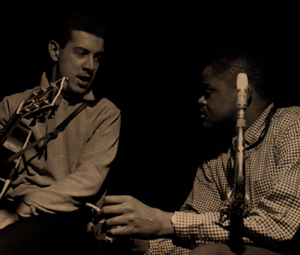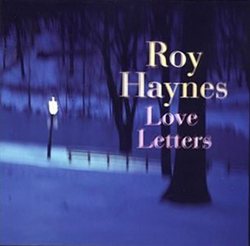

|
Soundclip:
|
| See Steve's Hand-Written Solo
Transcription |
|
Stanley Turrentine's solo on: "Love Letters"(Young-Heyman) If you have ever read any of the interviews with Michael Brecker where he lists his influences, the name of one saxophonist was also always present, even if many would not have placed his name alongside John Coltrane; Sonny Rollins; Wayne Shorter; and Joe Henderson, to name a few. To many, the name Stanley Turrentine is often associated with the label of "Soul Tenor Sax" or "Soul Jazz." There is really nothing wrong with that, but, it hardly captures the scope of the man's body of work. I suppose that I first became aware of Stanley Turrentine when I bought the 1963 recording, "MIDNIGHT BLUE" by the great, Kenny Burrell. During those years of discovery for me, each LP led me to the work of others. That one great recording caused me to investigate a trio of LPs from 1960-1963 by organist, Jimmy Smith which included: "BACK AT THE CHICKEN SHACK"; "MIDNIGHT SPECIAL"; and "PRAYER MEETIN'."  All these recordings hold up really well to this day. Because I too had been such a huge fan of Stanley's playing, his sound, the feeling, the phrasing, etc., I have often thought of presenting one of my transcriptions here, but, the detail involved in trying to write out 'blues' phrases with an elastic time feel and bent notes always prevented me from doing it. During my recent travels, having put together some Stanley Turrentine Samplers for my iTunes library, I finally felt that I could do some small justice to presenting his fantastic 2-chorus solo over Victor Young's "Love Letters" which appears on Stanley's recording from 1964, "HUSTLIN'"(Blue Note), which features: Shirley Scott(Organ); Kenny Burrell(Guitar); Bob Cranshaw(Ac. Bass); and Otis "Candy" Finch(Drums). All these recordings hold up really well to this day. Because I too had been such a huge fan of Stanley's playing, his sound, the feeling, the phrasing, etc., I have often thought of presenting one of my transcriptions here, but, the detail involved in trying to write out 'blues' phrases with an elastic time feel and bent notes always prevented me from doing it. During my recent travels, having put together some Stanley Turrentine Samplers for my iTunes library, I finally felt that I could do some small justice to presenting his fantastic 2-chorus solo over Victor Young's "Love Letters" which appears on Stanley's recording from 1964, "HUSTLIN'"(Blue Note), which features: Shirley Scott(Organ); Kenny Burrell(Guitar); Bob Cranshaw(Ac. Bass); and Otis "Candy" Finch(Drums).Believe or not, "Love Letters" was a pretty big hit recording in 1962 for singer, Ketty Lester, and, of all things, it was sung in 3/4. Other wonderful interpretations, all performed as ballads in 4/4, as the song appears on the official sheet music, can be found by: Dinah Washington; Peggy Lee; Tony Bennett; and Nat "King" Cole. It always fascinating that, in the hands of great Jazz musicians, the same song can be turned into a more uptempo swingin' affair! The actual "sheet music key" is in G major and more often than not, Jazz musicians tend to play the great standards in their sheet music keys. But, witness the version, at a medium tempo, as presented here by Stanley Turrentine and a quartet led by his wife, organist, Shirley Scott. They have moved the key to Bb major, which means that for Stanley and the tenor sax, he's playing in C major!!! Much better than having to perform the tune in A major which would have been the tenor sax key if the tune had remained in G major. Even when performed at a tempo which is brighter than any ballad, the statement of the melody never loses its sense of romance. One can't help but to be struck by Stanley's rich sound and the expressive manner in which he plays everything. You can really 'feel' the air passing through his horn. I used to hear tenor sax players describe this style as being very "foofy" perhaps, it should be spelled "phoofy" - I honestly don't know. Obviously, it's not a real word and doesn't sound the way we normally sound out any word with a double "o" - like "moon" or "fool." And it doesn't rhyme with a word like "fluffy" either. It is an in-between sound. In another time, I used to hear players talking and describing what they had heard from some tenor player, and they would say: "Yeah, he was really foofin' it!" In short, it's a "word" that gives rise to the usage of onomatopoeia. When one speaks of "sound" from this period of Jazz history, it is always important to mention the beautiful recording quality of Rudy Van Gelder's engineering. It's remarkable how even the finest students of sound design and mixing overlook Rudy's radical panning of the instruments, with Stanley's tenor sax hard left, Kenny Burrell's guitar hard right, and Otis Finch's drums hard right as well. The organ and the acoustic bass are in the center. We have all listened to the recordings of this time period so much that we have forgotten these most interesting details. Turrentine's solo begins with a very simple, classic 2-bar "solo break" which, apart from the momentary chromaticism of F-E-Eb, is all very diatonic and really just outlines the basic chords. But, what makes it all work and sound so expressive is his elastic but swingin' time feel. It is no less wonderful that he just never seems to be 'in a hurry' to get anywhere, nor to immediately just into double-time phrases. In bars 1-2, Stanley simply outlines Bbmaj7 in nice, long 1/2-notes with each one sitting on the fat part of the beat. Of course, the note that he leaves out is Bb, the root, and this is what I have always shared with my students. Even though Bb is the root of the chord, when one is playing over a major 7th chord in a Jazz context, the root, when placed in a position of too much emphasis can actually sound like a 'bad' note because of its proximity, by a 1/2-step, to the major 7th. Throughout the solo, when there is a cadence to Bbmaj7, the only Bb you will find is during [A2] of Chorus 1, and it is, as it should be, a very short note. At the end of the solo, on Pg. 2, Bb, the root, appears again but here it is applied as a blues phrase ends. That is another case where the root can sound perfectly fine, and who better to execute that then Stanley Turrentine?  After his cadence to Dm7 in bar 11, Stanley begins 6 bars of wonderful double-time phrasing which is rich with the shapes of lines that have formed the better part of the Jazz tradition for decades. Studying bars 11 through 18 will serve as a perfect lesson for anyone who desires to understand just how to shape and form their own lines. In bars 11-12, over the Dm7, his line begins with a classic configuration when playing over any m7 chord, here you see, E(9th)-C#(maj7)-D(Root)-E(2nd)-F(m3rd), etc. but, what makes Stanley Turrentine so different is the very bluesy way he vaults to his high 'D' and descends utilizing another blues mannerism. During his execution of the ii-V to i-minor in bars 13-15, he plays something which normally I would never recommend when one is cadencing to a minor chord. I am speaking of the usage of the diminished scale. This appears in bar 14. You see a G 1/2-tone/whole/tone diminished scale[G, Ab, Bb, B, C#(Db), D, E, F] put to use. Generally speaking, the 'problem note' is the presence of the E-natural. The idea of resolving from an E-natural down to an Eb for the Cm7 chord is really awful. So, one wants to avoid that problem at all costs. But, as Stanley has used the diminished scale here, the E-natural is masked within the line, as it begins on the 5th(D) and ascends to Ab(b9) before cadencing and surrounding the Eb with a 'G' above and a 'D' below. For this reason, it works very well. He also puts to use another familiar yet wonderful "Jazz linear trick" by approaching the Cm7b5 with lines that configure themselves in the same manner as if they were Eb Dorian. If you look closely at bar 15, you will see him ascending from the note Eb in a manner that clearly indicates Eb Dorian, and this holds true for that entire bar. In bar 16 of [A], over the F7(alt.) chord, you hear the traditional cadence sounds of a line that accentuates the #9(Ab) and b9(Gb) which both appear before the cadence to Bb and [A2].
After his cadence to Dm7 in bar 11, Stanley begins 6 bars of wonderful double-time phrasing which is rich with the shapes of lines that have formed the better part of the Jazz tradition for decades. Studying bars 11 through 18 will serve as a perfect lesson for anyone who desires to understand just how to shape and form their own lines. In bars 11-12, over the Dm7, his line begins with a classic configuration when playing over any m7 chord, here you see, E(9th)-C#(maj7)-D(Root)-E(2nd)-F(m3rd), etc. but, what makes Stanley Turrentine so different is the very bluesy way he vaults to his high 'D' and descends utilizing another blues mannerism. During his execution of the ii-V to i-minor in bars 13-15, he plays something which normally I would never recommend when one is cadencing to a minor chord. I am speaking of the usage of the diminished scale. This appears in bar 14. You see a G 1/2-tone/whole/tone diminished scale[G, Ab, Bb, B, C#(Db), D, E, F] put to use. Generally speaking, the 'problem note' is the presence of the E-natural. The idea of resolving from an E-natural down to an Eb for the Cm7 chord is really awful. So, one wants to avoid that problem at all costs. But, as Stanley has used the diminished scale here, the E-natural is masked within the line, as it begins on the 5th(D) and ascends to Ab(b9) before cadencing and surrounding the Eb with a 'G' above and a 'D' below. For this reason, it works very well. He also puts to use another familiar yet wonderful "Jazz linear trick" by approaching the Cm7b5 with lines that configure themselves in the same manner as if they were Eb Dorian. If you look closely at bar 15, you will see him ascending from the note Eb in a manner that clearly indicates Eb Dorian, and this holds true for that entire bar. In bar 16 of [A], over the F7(alt.) chord, you hear the traditional cadence sounds of a line that accentuates the #9(Ab) and b9(Gb) which both appear before the cadence to Bb and [A2].Stanley begins [A2] with a rather classic linear device in bars 1-2 where one surrounds the basic notes from a triad with their consonant upper-neighbor and their chromatic lower neighbor. Most musicians, at one point or another in their studies, have played this very same idea as a technical or velocity exercise. It remains excellent for developing such things. From there, he turns to his roots, the blues, and this continues until the arrival of bar 7 of this section. With the arrival of the ii-V to Ebmaj7, you see his very nice usage of Bb7 augmented arpeggios, where the actual augmented triad is highlighted and then resolves perfectly to the 3rd of Ebmaj7 in bar 9. As he negotiates all the changes in a most relaxed manner, one can't help but be taken with his time feel. In the passages that conlude this first chorus, he artfully plays behind the beat, but when he needs to, he digs in and can be right on it!!! Notice how forcefully he lands on beat 1 of bar 13 with that high Bb! As the chorus ends and works its way towards the resolution into Chorus 2, Stanley Turrentine shouts the blues as only he could do it. As Chorus 2 continues, and the changes move to the relative minor, Gm7, Stanley continues with a bluesy approach. But, as the ii-V to Bbmaj7 arrives in bar 5, his phrasing becomes markedly more Jazzy in orientation. The nice double-time line over the F7 chord once again places a harmonic emphasis at the end on the b9(Gb) and #9(Ab). When the Bbmaj7 arrives, he plays the same arpeggio that he used in bars 1-3: F-D-A-F-G - only this time, it's in double-time. He completes this phrase by putting to use a variation of what also appeared prevoiusly in [A2] of Chorus 1, bars 1-2. The difference is that here, the chord tone is in the middle of the phrase, and it's also the destination: C-Bb-A-Bb to Eb-D-C#-D. Had he continued, you would have then seen: G-F-E-F. As bar 9 arrives, once again, just as it was in Chorus 1 during the same bars, he places great emphasis on his high 'C' over the Em7b5 chord. And, over the A7(alt.), he uses the same traditional descending triplet grouping: Bb(b9)-F(#5)-Db(3rd)-C(#9). It is all performed with grace and incredible swing. Bars 11-12 continue with a blues-based approach to Dm7 and even a bent-note on the 'blue note' of Ab over this chord. In bars 13-15, the Jazz nature of his lines returns, and there's a wonderful descending line beginning on the 2nd half of bar 13 which goes down to B-natural, the 3rd of G7 and vaults up to Bb(#9) which a most traditional line configuration for any player steeped in the tradition. Once again as the Cm7b5 arrives, you can clearly hear and see the importance of a linear approach from Eb Dorian. This is such a useful tool for anyone who has ever felt uncomfortable playing over m7b5 chords. Try using the Jazz lines that align themselves with the Dorian mode built upon the minor 3rd of the chord. You can't go wrong!  In bar 16 of [A], Stanley Turrentine returns to the blues language by playing note associated with the tonic, where he's headed, even though he's still on the V7 chord. As bar 1 of [A2] he lands beautifully with a very traditional phrase using Bb blues as its base, but being played of a Bbmaj7 chord. In bar 3, with the arrival of the Gm7 chord, he plays his highest note of the entire solo, a high G-natural and it is the way that he expresses this note that made his playing, all or in part, so appealing to Mike Brecker and countless others. I wish that I could tell you all the saxophone mechanics of making a note sound exactly the way he makes his short notes, in his upper register sound, but, it's not my instrument. I just know that it is certainly something to be emulated. You hear this kind of sound from the great R&B tenor sax players of the same ear, players like "King" Curtis and Junior Walker. If you are not familiar with either them, this would be a great time to investigate their work. As the solo moves through bars 5-12, and we once again his the ii-V to Ebmaj7, you see Stanley's vocabulary changing to a Jazz orientation with a nice, traditional line over the Fm7/Bb. Then, once again, over the Bb7(alt.) chord in bar 8, he relies upon the Bb augmented triad, this time with a high Db, blue-note, thrown-in, for soulful good measure! And, once again, he cadences to the Ebmaj7 by landing on G-natural, the 3rd of the chord. As the progression moves to Ab7(9), his line changes to Eb Dorian, before returning to Bb major, and playing very diatonically through bars 11-12. As his solo draws to its conclusion, notice how he sits on the big, fat quarter-notes in bar 13, and how that phrase shifts to swingin' 8th-notes in bar 14. Finally, with a nice breath in bar 15, he hits his high Bb, and brings us back down to earth with one final blues phrase leading back to bar 1 of the next chorus as Shirley Scott's organ solo begins.
In bar 16 of [A], Stanley Turrentine returns to the blues language by playing note associated with the tonic, where he's headed, even though he's still on the V7 chord. As bar 1 of [A2] he lands beautifully with a very traditional phrase using Bb blues as its base, but being played of a Bbmaj7 chord. In bar 3, with the arrival of the Gm7 chord, he plays his highest note of the entire solo, a high G-natural and it is the way that he expresses this note that made his playing, all or in part, so appealing to Mike Brecker and countless others. I wish that I could tell you all the saxophone mechanics of making a note sound exactly the way he makes his short notes, in his upper register sound, but, it's not my instrument. I just know that it is certainly something to be emulated. You hear this kind of sound from the great R&B tenor sax players of the same ear, players like "King" Curtis and Junior Walker. If you are not familiar with either them, this would be a great time to investigate their work. As the solo moves through bars 5-12, and we once again his the ii-V to Ebmaj7, you see Stanley's vocabulary changing to a Jazz orientation with a nice, traditional line over the Fm7/Bb. Then, once again, over the Bb7(alt.) chord in bar 8, he relies upon the Bb augmented triad, this time with a high Db, blue-note, thrown-in, for soulful good measure! And, once again, he cadences to the Ebmaj7 by landing on G-natural, the 3rd of the chord. As the progression moves to Ab7(9), his line changes to Eb Dorian, before returning to Bb major, and playing very diatonically through bars 11-12. As his solo draws to its conclusion, notice how he sits on the big, fat quarter-notes in bar 13, and how that phrase shifts to swingin' 8th-notes in bar 14. Finally, with a nice breath in bar 15, he hits his high Bb, and brings us back down to earth with one final blues phrase leading back to bar 1 of the next chorus as Shirley Scott's organ solo begins.In case some of you are wondering just who might have been some of Stanley Turrentine's earliest influences, I have read that his major influences included: Don Byas, Ben Webster, Illinois Jacquet, Lester Young, Coleman Hawkins and Sonny Rollins. And there are those who hear a lot of Ben Webster in his playing too. A native of Pittsburgh, Pennsylvania, one of Stanley's first big gigs was playing in bluesman Lowell Fulson's band in 1953, where he played alongside a most gifted young pianist/singer named Ray Charles! He later went on to actually replace another musician of great destiny, an as yet unknown saxophonist named, John Coltrane in R&B saxophonist Earl Bostic's band. So now you have a bit of background information on this wonderful and most unique player.  In 2002, on his CD, "LOVE LETTERS," drummer Roy Haynes recorded this wonderful standard with John Scofield and Dave Holland rounding out the trio. For whatever the reason might have been, they chose to record the tune in the "sheet music key" of G major. I have given you the changes that they used on Pg. 2 of this transcription. However, below, I thought that it would be of some service to point out how each of these wonderful interpretations chose to treat the [A2] section. To lessen the degree of work that you might have to do transposing, I have done it for you, and the Scofield changes are presented within the brackets and in red. The first nice touch appears in bar 4 where Gm7 becomes G7/B to pull more effectively to Cm7 in bar 5. However, beginning in bars 7-12, the differences between the two versions begins to show itself. In truth, it was the Stanley Turrentine-Shirley Scott version that made some significant alterations, while the Scofield-Haynes version puts to use the more traditional set of changes. Needless to say, both versions are great. And, for all you guitar fans out there, if you haven't heard it, check out John Scofield's playing over this tune on the Roy Haynes CD. It would be well worth it.
In 2002, on his CD, "LOVE LETTERS," drummer Roy Haynes recorded this wonderful standard with John Scofield and Dave Holland rounding out the trio. For whatever the reason might have been, they chose to record the tune in the "sheet music key" of G major. I have given you the changes that they used on Pg. 2 of this transcription. However, below, I thought that it would be of some service to point out how each of these wonderful interpretations chose to treat the [A2] section. To lessen the degree of work that you might have to do transposing, I have done it for you, and the Scofield changes are presented within the brackets and in red. The first nice touch appears in bar 4 where Gm7 becomes G7/B to pull more effectively to Cm7 in bar 5. However, beginning in bars 7-12, the differences between the two versions begins to show itself. In truth, it was the Stanley Turrentine-Shirley Scott version that made some significant alterations, while the Scofield-Haynes version puts to use the more traditional set of changes. Needless to say, both versions are great. And, for all you guitar fans out there, if you haven't heard it, check out John Scofield's playing over this tune on the Roy Haynes CD. It would be well worth it.Again, you can compare and contrast the changes during the first 12 bars of the [A2] section of each interpretation: | Cm7[Cm7] / / / | F7[F7] / / / | Fm7/Bb[Dm7b5] / / / | Bb7(alt.)[G7(alt.)] / / / | | Ebmaj7[Cm7] / / / | Ab7(9b5)[Ebm7] / [Ab7] / | Bbmaj7[Dm7] / Eb7(9) / | Dm7[G7(alt.)] / G7(alt.) / ] || To present something at Korner 1 by Stanley Turrentine has been a great thrill for me. As I had stated originally, anytime one tries to write out the solo of a player deeply steeped in the traditions of the blues, it is going to be difficult because of the loose and elastic nature of the phrases that are so tied to this rich genre. As this site is mostly frequented by guitarists, it is so important that those of you, who fall into that category, try to take advantage of all that this wonderful player and this great solo have to offer. The guitar can never sound like the tenor sax, but there is no reason why one could not place that 'sound' deep within, and have that kind of body appear in their own tone. The other aspect which could surely be emulated would be Stanley's incredibly swingin' phrasing and his time feel. If it needs to be restated, don't ever forget that Michael Brecker always listed Stanley Turrentine amongst his most profound influences!! 'Nuff said!!! Enjoy this one to the fullest! As this Summer of 2009 comes to a close, we want to take this opportunity to wish everyone a wonderful Autumn as the leaves turn to flame and the temperatures begin to become more bearable. Thanks again to everyone for their wonderful messages via the CONTACT STEVE page, as well as the supportive comments that appear in our GUESTBOOK.
[Photo of Shirley Scott & Stanley Turrentine
Photo of Kenny Burrell & Stanley Turrentine by: Francis Wolff] |